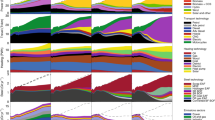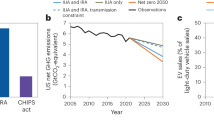Abstract
Stabilizing global greenhouse gas concentrations at levels to avoid significant climate risks will require massive “decarbonization” of all the major economies over the next few decades, in addition to the reduced emissions from other GHGs and carbon sequestration. Achieving the necessary scale of emissions reductions will require a multifaceted policy effort to support a broad array of technological and behavioral changes. Change on this scale will require sound, well-thought-out strategies. In this article, we outline some core principles, drawn from recent social science research, for guiding the design of clean technology policies, with a focus on energy. The market should be encouraged to make good choices: pricing carbon emissions and other environmental damage, removing distorting subsidies and barriers to competition, and supporting RD&D broadly. More specific policies are required to address particular market failures and barriers. For those technologies identified as being particularly desirable, some narrower RD&D policies are available.

Similar content being viewed by others
Notes
For a broader discussion of the interaction among emissions pricing, spillovers, and public support for environmentally friendly technologies, see Fischer (2008).
Fischer and Newell (2008) show that, even with knowledge spillovers, policy cost-effectiveness depends largely on the degree to which all options for reducing emissions are encouraged. While emissions pricing is the single most effective policy, an optimal portfolio also includes RD&D support, achieving emissions reductions at significantly lower cost than any single policy.
Many of these subsidies take the form of preferential tax treatment, relative to other sectors. The oil and gas industries in the United States and Canada have benefited from such provisions as accelerated depreciation, the expensing of exploration and development costs, and other investment tax breaks; direct expenditures on infrastructure and RD&D; and the incomplete capture of resource rents through royalties—many of which disproportionately support the development of the relatively dirty oil sands (Taylor et al. 2005).
See, for example, Jones and Williams (1998).
In this regard, an opportunity cost is associated with government RD&D spending, since this money could be spent in other areas, where spillover effects could be equally large or larger.
For a discussion of technology-oriented agreements, see de Coninck et al. (2008).
See also Popp (2011) for insights into technology transfer policies.
Researchers from other disciplines are commonly more in favor of supporting specific technologies than are economists. One example is Azar and Sandén (2011), who argue that a fully technology-neutral policy neither exists nor would be desirable when the aim is to achieve a large-scale transition of the global energy system. Instead, technology policies should be openly debated in society.
An example is the Ontario Centres of Excellence, which operate somewhat like a publicly funded venture capital firm.
References
ADB (Asian Development Bank). 2009. Improving energy security and reducing carbon intensity in Asia and the Pacific. Manila: Asian Development Bank.
Azar, C., and B.A. Sandén. 2011. The elusive quest for technology-neutral policies. Environmental Innovation and Societal Transitions 1: 135–139.
de Coninck, H., C. Fischer, R.G. Newell, and T. Ueno. 2008. International technology-oriented agreements to address climate change. Energy Policy 36: 335–356.
Fell, H., D. Burtraw, R. Morgenstern, K. Palmer, and L. Preonas. 2009. Soft and hard price collars in a cap-and-trade system. A comparative analysis. Discussion paper 10-27-REV. Washington, DC: Resources for the Future.
Fischer, C. 2008. Emissions pricing, spillovers, and public investment in environmentally friendly technologies. Energy Economics 30: 487–502.
Fischer, C. 2009. The role of technology policies in climate mitigation. RFF issue brief 09–08. Washington, DC: Resources for the Future.
Fischer, C., and R. Newell. 2008. Environmental and technology policies for climate mitigation. Journal of Environmental Economics and Management 55: 142–162.
Fischer, C., and L. Preonas. 2010. Combining policies for renewable energy: Is the whole less than the sum of its parts? International Review of Environmental and Resource Economics 4: 51–92.
Fischer, C., and T. Sterner. forthcoming. Climate policy, uncertainty, and the role of technological innovation. Journal of Public Economic Theory.
GCN (Global Climate Network). 2009. Breaking through on technology: Overcoming the barriers to the development and wide deployment of low-carbon technology. Global climate network discussion paper no. 2. Global climate network. http://www.globalclimatenetwork.info.
GCN (Global Climate Network). 2010. Investing in clean energy: How can developed countries best help developing countries finance climate-friendly energy investments? Discussion paper 4. http://www.globalclimatenetwork.info/ecomm/files/Investing%20in%20Clean%20Energy%20Nov2010.pdf.
Gerlagh, R., S. Kverndokk, and K.E. Rosendahl. 2008. Linking environmental and innovation policy. FEEM working paper no. 53. Milan: Fondazione Eni Enrico Mattei.
IEA (International Energy Agency). 2002. Reforming energy subsidies. Paris: IEA and UNEP Division of Technology, Industry and Economics.
IEA (International Energy Agency). 2006. Carrots and sticks: Taxing and subsidising energy. Economic analysis division note on energy subsidies and taxes. Paris: IEA.
Jones, C.I., and J.C. Williams. 1998. Measuring the social return to R&D. The Quarterly Journal of Economics 113: 1119–1135.
Lindman, Å., and P. Söderholm. 2011. Wind power learning rates: A conceptual review and meta-analysis. Energy Economics. doi:10.1016/j.eneco.2011.05.007.
McDonald, A., and L. Schrattenholzer. 2002. Learning curves and technology assessment. International Journal of Technology Management 23: 718–745.
Newell, R.G., and N.E. Wilson. 2005. Technology prizes for climate change mitigation. Discussion paper 05-33. Washington, DC: Resources for the Future.
Ockwell, D.G., J. Watson, G. MacKerron, P. Pal, and F. Yamin. 2008. Key policy considerations for facilitating low carbon technology transfer to developing countries. Energy Policy 36: 4104–4115.
OECD and IEA (Organisation for Economic Co-operation and Development and International Energy Agency). 2003. Technology innovation, development and diffusion. COM/ENV/EPOC/IEA/SLT(2003)4. Paris: OECD/IEA.
OECD and IEA (Organisation for Economic Co-operation and Development and International Energy Agency). 2008. CO 2 capture and storage—A key abatement technology: Energy technology analysis. Paris: OECD/IEA.
Pacala, S., and R. Socolow. 2004. Stabilization wedges: Solving the climate problem for the next 50 years with current technologies. Science 305: 968–972.
Popp, D. 2011, Winter. International technology transfer for climate policy. Review of Environmental Economics and Policy 5(1): 131–152.
Requate, T. 2005. Dynamic incentives by environmental policy—A survey. Ecological Economics 54: 175–195.
Rubin, E.S., S. Yeh, M. Antes, M. Berkenpas, and J. Davison. 2007. Use of experience curves to estimate the future cost of power plants with CO2 capture. International Journal of Greenhouse Gas Control 1: 188–197.
Shapira, P., and S. Rosenfeld. 1996. An overview of technology diffusion policies and programs to enhance the technological absorptive capabilities of small and medium enterprises. Background paper prepared for the OECD Directorate for Science, Technology and Industry, Paris. http://ciber.gatech.edu/papers/workingpaper/1997/shapira2.pdf.
Shrivastava, M.K. 2008. Climate change and technology: Building capabilites. TERI viewpoint paper 1. New Delhi: The Energy and Resources Institute.
Shrivastava, M.K. 2009. Towards a green techno-economic paradigm. Resources, Energy and Development 6: 67–80.
Shrivastava, M.K., and H. Upadhyay. 2009. Climate change and technology: Perceptions from India. Discussion paper TERI/GCN-2009:1. New Delhi: The Energy and Resources Institute.
Stern, N. 2007. The economics of climate change: The stern review. Cambridge, UK: Cambridge University Press.
Sterner, T. 2012. Fuel taxes and the poor: The distributional effects of gasoline taxation and their implications for climate policy. New York and London: RFF Press/Taylor & Francis.
Stigson, P., E. Dotzauer, and J. Yan. 2009. Improving policy making through government–industry policy learning: The case of a novel Swedish policy framework. Applied Energy 86: 399–406.
Stigson, P., E. Dotzauer, and J. Yan. 2010. Voluntary agreements as a vehicle for policy learning. International Journal of Global Warming 2: 97–117.
Taylor, A., M. Bramley, and M. Winfield. 2005. Government spending on Canada’s oil and gas industry: Undermining Canada’s Kyoto commitment. Pembina Institute Report. AB, Canada: Climate Action Network.
Torvanger, A., and J. Meadowcroft. 2011. The political economy of technology support: Making decisions about CCS and low carbon energy technologies. Global Environmental Change 21: 303–312.
Unruh, G. 2000. Understanding carbon lock-in. Energy Policy 28: 817–830.
Zhao, M. 2006. Conducting R&D with weak intellectual rights protection. Management Science 52(8): 1185–1199.
Acknowledgments
We gratefully acknowledge financial support from the Mistra Foundation’s Climate Policy Research Program (Clipore). Thanks also to two anonymous referees for their valuable comments. This article expands upon an earlier issue brief, Fischer (2009).
Author information
Authors and Affiliations
Corresponding author
Rights and permissions
About this article
Cite this article
Fischer, C., Torvanger, A., Shrivastava, M.K. et al. How Should Support for Climate-Friendly Technologies Be Designed?. Ambio 41 (Suppl 1), 33–45 (2012). https://doi.org/10.1007/s13280-011-0239-0
Published:
Issue Date:
DOI: https://doi.org/10.1007/s13280-011-0239-0




